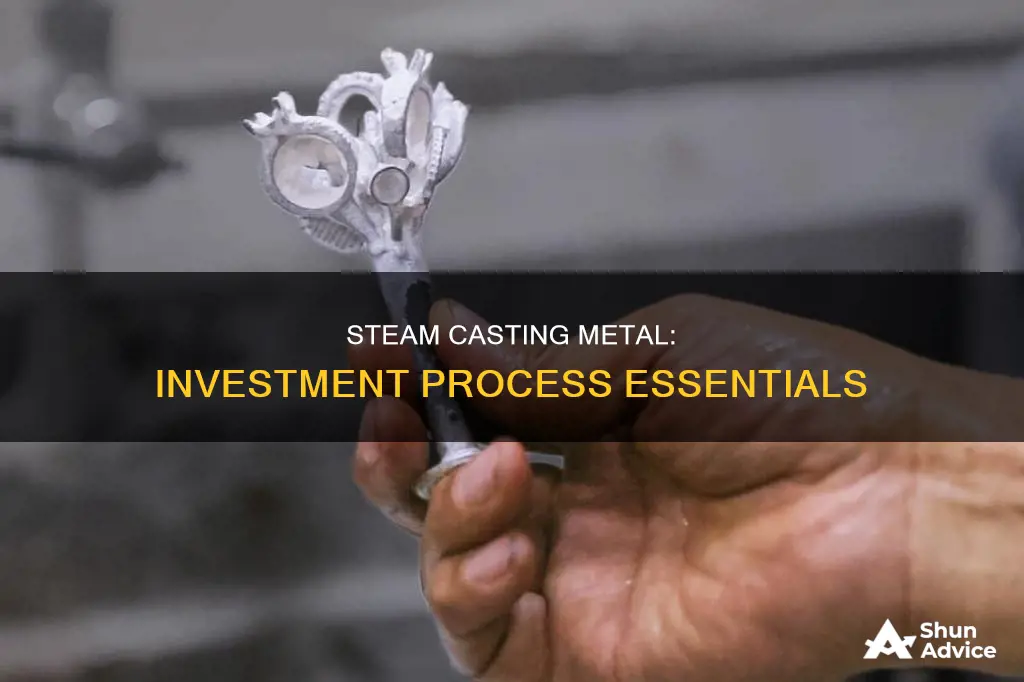
Investment casting, also known as lost wax casting, is a manufacturing process that uses a wax pattern to shape a disposable ceramic mould. This process is used to steam cast metal and involves several intricate steps. First, a wax pattern is made in the exact shape of the item to be cast. This pattern is then coated with a refractory ceramic material. Once the ceramic material has hardened, it is turned upside down and heated until the wax melts and drains out, leaving a hollow ceramic shell. Molten metal is then poured into the mould and left to cool. Finally, the metal casting is broken out of the mould, revealing a high-precision metal component.
| Characteristics | Values |
|---|---|
| Process Name | Investment Casting |
| Other Names | Lost Wax Casting, Precision Casting |
| Materials Used | Wax, Ceramic, Metal |
| Process Steps | 1. Create Wax Pattern, 2. Assemble Wax Pattern, 3. Apply Refractory Materials, 4. Dewaxing, 5. Preheating & Casting, 6. Finishing |
| Master Pattern Materials | Wax, Wood, Metal, Silicone Rubber |
| Metal Types | Any metal, e.g. Stainless Steel, Aluminum, Alloys |
| Advantages | High Precision, Smooth Surfaces, Complex Shapes, Thin Walls, Fine Details, Low Waste |
| Disadvantages | High Costs, Time-Consuming, Error-Prone, Limited Size and Weight |
| Applications | Turbine Blades, Gears, Jewellery, Medical Equipment, Firearm Components |
What You'll Learn

Wax pattern creation
Once the wax pattern is created, it is assembled with other wax components to form the gate and runner metal delivery system. This process is known as mounting the wax patterns and creating the tree. Multiple wax patterns may be processed using a single tree, depending on the size and configuration of the desired final component. The wax patterns are injected and glued onto a pre-fabricated wax runner system, known as a "tree". The tree cluster is then sent to the Dip Room for the next step in the process.
The wax pattern creation step is important as it sets the foundation for the entire investment casting process. It ensures that the final metal component will have the desired shape and details. The wax pattern needs to be precise and accurate, as any deviations from the intended design will be carried through to the final product.
After the wax pattern is created and assembled, the next step is to build the ceramic mold. This involves coating the wax pattern with a ceramic material that will harden to form a mold. The pattern is repeatedly dipped into a ceramic slurry and sprinkled with fine sand to create a thick ceramic shell around the wax. This process creates a strong mold that can withstand the high temperatures required for molten metal casting.
In summary, wax pattern creation is a critical step in the investment casting process. It involves crafting a detailed wax pattern that is an exact replica of the final part, assembling it with other wax components, and then coating it with a ceramic material to create a mold. This step ensures that the final metal component will have the desired shape and intricate details.
Investment Cash Flow: Essential for Business Growth and Stability
You may want to see also

Ceramic mould construction
- The wax pattern is dipped into a ceramic slurry, which is a mixture of fine refractory powder and a binder liquid. Common materials used for the slurry include silica, zircon, aluminium silicate, and alumina.
- The coated assembly is manipulated to drain off excess slurry and create a uniform wet layer.
- The assembly is then stuccoed with a similar material that has relatively coarse particles. This is done by immersing the assembly into a fluidized particle bed or by sprinkling the particles onto the assembly.
- The coating is allowed to harden through drying or chemical gelling. Air drying at room temperature with controlled temperature and humidity is commonly used.
- The above steps are repeated several times (typically 6 to 8 times) to create a strong ceramic shell around the wax pattern. This process can take 24 to 72 hours, depending on the size of the component.
- The shell is then fired at a high temperature (around 870-1095°C) to remove any remaining wax and to strengthen the ceramics.
- If any cracks are found during the firing process, they are repaired with ceramic slurry or special cements before proceeding to the next step.
- The mould is preheated to a specific temperature to prepare it for accepting molten metal.
- Molten metal is then poured into the mould, filling the cavity left by the wax and capturing all the intricate details of the final product's geometry.
The ceramic mould construction process ensures the creation of a strong and accurate mould that can withstand the casting process and produce precise and complex metal components.
Credit Card Investing: A Guide to Mutual Funds
You may want to see also

Wax removal
Melting the Wax
The wax pattern, which is an exact replica of the final part, is coated with a ceramic material to create a mold. Once the ceramic coating is dry and hardened, the wax is melted and removed. This can be done through autoclaving, a steam-based process that uses high pressure and steam heat to melt and drain the wax. The wax can also be melted in a kiln or microwave, depending on the scale of the project.
Burning Out Remaining Wax
After the initial wax removal, the ceramic shell is placed in a furnace to burn out any remaining wax that has soaked into the ceramic. This step ensures that the wax pattern and gating material are completely removed, leaving a clean and precise cavity for the molten metal. The high-temperature operation also increases the strength and stability of the ceramic material.
Preparing the Ceramic Mold
Once the wax has been removed, the ceramic shell is moved to the foundry ovens to start the casting process. The mold is placed in a high-temperature oven, approximately 1000°C (1832°F), to cure the ceramic and prepare it for accepting molten metal. This curing process ensures that the ceramic mold can withstand the heat and pressure of the molten metal.
Finalizing the Wax Removal
After the curing process, the mold is preheated to a specific temperature and is now ready for the molten metal to be poured in. This step completes the wax removal process, as the cavity left by the wax will be filled with metal, creating the desired cast part.
The wax removal process is crucial in investment casting as it ensures the precise replication of intricate details in the final metal component. This process allows for exceptional precision and complex geometries, making it a popular choice for industries that require high-quality and durable parts, such as aerospace, automotive, and medical industries.
Smart Ways to Invest 50K Cash for Maximum Returns
You may want to see also

Metal casting
The first step in metal casting is to create a wax pattern that is an exact replica of the final part's design. This can be done using a wax injection mold or, more recently, through 3D printing. Multiple wax patterns may be needed, especially if creating numerous parts in one mold. These patterns are then assembled onto a central wax "tree", which provides a pathway for the molten metal to flow smoothly.
The wax pattern assembly is then dipped into a ceramic slurry and coated with sand stucco to create a strong ceramic shell. This process is repeated several times until the desired thickness is achieved. The thickness will depend on the size and weight of the cast object and the melting temperature of the metal being used.
The ceramic shell is then heated to melt and remove the wax, creating a hollow mold. This step is crucial as it prepares the mold to accept molten metal and ensures that the final product retains the intricate details of the original wax pattern.
The mold is then preheated to a high temperature, typically around 1000°C, and filled with molten metal. This step requires extreme precision to ensure a high-quality cast. Once the metal has cooled and solidified, the ceramic shell is broken away, revealing the metal component.
The final steps involve finishing processes such as grinding, machining, and polishing to refine the surface and ensure the part meets the required specifications.
Fidelity Investments and Zelle: What's the Connection?
You may want to see also

Finishing touches
Once the metal has cooled and solidified, the ceramic shell is carefully broken away to reveal the cast part. This process can be done manually or with water jets, vibration, or other methods. The cast part is then separated from the gating system, which is not part of the final product. This can be done by cutting it off with a saw or using liquid nitrogen.
The cast part then undergoes finishing processes to meet final specifications. This includes semi-finishing operations such as machining, grinding, or blasting to remove any rough surfaces, jagged edges, or other defects. Machining operations like milling and drilling are also done to finish holes and surfaces. The cast part may also undergo surface finish treatments to achieve the desired surface quality.
After the finishing processes, the part goes through a quality inspection to ensure it meets industry standards and client specifications. This includes checking for defects such as cracks and porosity, as well as verifying geometric and dimensional tolerances, hardness, and strength.
Once the finishing touches are complete, the cast part is ready for assembly or further processing.
Fidelity's Cash Management Account: A Smart Investment Move?
You may want to see also
Frequently asked questions
Investment casting, also known as lost wax casting, is a manufacturing process that uses a wax pattern to shape a disposable ceramic mold. The wax pattern, an exact replica of the final product, is coated with a ceramic material. Once the ceramic hardens, the mold is heated and the wax melts and drains out, leaving a hollow shell. Molten metal is then poured into this shell, creating a precise metal component.
Investment casting offers several advantages over other casting methods, such as sand casting and die casting. It allows for high levels of detail and precision, making it suitable for complex shapes and intricate designs. This process can produce castings with tight tolerances, thin walls, and smooth surfaces. It also offers versatility in terms of material selection, including various metals and alloys.
The steps typically include creating a wax pattern, assembling multiple patterns into a tree-like structure, applying refractory materials through dipping, removing the wax through a dewaxing process, preheating the mold, casting the metal, and finalizing the castings through finishing operations. Each step requires precision and care to ensure a successful final product.







